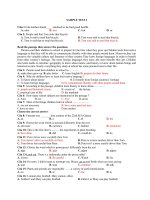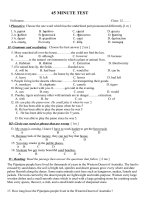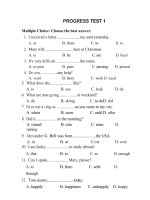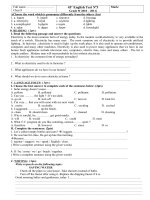Tài liệu Biology Test - Practice Book
Bạn đang xem bản rút gọn của tài liệu. Xem và tải ngay bản đầy đủ của tài liệu tại đây (3.74 MB, 71 trang )
GRADUATE RECORD EXAMINATIONS
®
Biology Test
Practice Book
Listening.
Learning.
Leading.
This practice book contains
Ⅲ one actual full-length GRE Biology Test
Ⅲ test-taking strategies
Become familiar with
Ⅲ test structure and content
Ⅲ test instructions and answering procedures
Compare your practice test results with the performance of those who
took the test at a GRE administration.
Visit GRE Online at www.gre.org
This book is provided FREE with test registration by the Graduate Record Examinations Board.
Copyright © 2001 by Educational Testing Service. All rights reserved.
EDUCATIONAL TESTING SERVICE, ETS, the ETS logos, GRADUATE RECORD EXAMINATIONS,
and GRE are registered trademarks of Educational Testing Service.
Note to Test Takers: Keep this practice book until you receive your score report.
The book contains important information about content specifications and scoring.
3
BIOLOGY TEST
PRACTICE BOOK
Purpose of the GRE
Subject Tests
The GRE Subject Tests are designed to help gradu-
ate school admission committees and fellowship
sponsors assess the qualifications of applicants in
specific fields of study. The tests also provide you
with an assessment of your own qualifications.
Scores on the tests are intended to indicate
knowledge of the subject matter emphasized in
many undergraduate programs as preparation for
graduate study. Because past achievement is usually
a good indicator of future performance, the scores
are helpful in predicting success in graduate study.
Because the tests are standardized, the test scores
permit comparison of students from different
institutions with different undergraduate programs.
For some Subject Tests, subscores are provided in
addition to the total score; these subscores indicate
the strengths and weaknesses of your preparation,
and they may help you plan future studies.
The GRE Board recommends that scores on the
Subject Tests be considered in conjunction with
other relevant information about applicants. Because
numerous factors influence success in graduate
school, reliance on a single measure to predict
success is not advisable. Other indicators of compe-
tence typically include undergraduate transcripts
showing courses taken and grades earned, letters of
recommendation, the GRE Writing Assessment
score, and GRE General Test scores. For information
about the appropriate use of GRE scores, write to
GRE Program, Educational Testing Service, Mail
Stop 57-L, Princeton, NJ 08541, or visit our Web site
at www.gre.org/codelst.html.
Development of the
Subject Tests
Each new edition of a Subject Test is developed by
a committee of examiners composed of professors in
the subject who are on undergraduate and graduate
faculties in different types of institutions and in
different regions of the United States and Canada.
In selecting members for each committee, the GRE
Program seeks the advice of the appropriate profes-
sional associations in the subject.
The content and scope of each test are specified
and reviewed periodically by the committee of
examiners. Test questions are written by the com-
mittee and by other faculty who are also subject-
matter specialists and by subject-matter specialists
at ETS. All questions proposed for the test are
reviewed by the committee and revised as necessary.
The accepted questions are assembled into a test in
accordance with the content specifications devel-
oped by the committee to ensure adequate coverage
of the various aspects of the field and, at the same
time, to prevent overemphasis on any single topic.
The entire test is then reviewed and approved by
the committee.
Table of Contents
Purpose of the GRE Subject Tests 3
Development of the Subject Tests 3
Content of the Biology Test 4
Preparing for a Subject Test 7
Test-Taking Strategies 7
What Your Scores Mean 8
Practice Biology Test 11
Scoring Your Subject Test 65
Evaluating Your Performance 68
Answer Sheet 69
4
BIOLOGY TEST
PRACTICE BOOK
Subject-matter and measurement specialists
on the ETS staff assist the committee, providing
information and advice about methods of test con-
struction and helping to prepare the questions and
assemble the test. In addition, each test question is
reviewed to eliminate language, symbols, or content
considered potentially offensive, inappropriate for
major subgroups of the test-taking population, or
likely to perpetuate any negative attitude that may be
conveyed to these subgroups. The test as a whole is
also reviewed to ensure that the test questions, where
applicable, include an appropriate balance of people
in different groups and different roles.
Because of the diversity of undergraduate cur-
ricula, it is not possible for a single test to cover all
the material you may have studied. The examiners,
therefore, select questions that test the basic knowl-
edge and skills most important for successful graduate
study in the particular field. The committee keeps the
test up-to-date by regularly developing new editions
and revising existing editions. In this way, the test
content changes steadily but gradually, much like
most curricula. In addition, curriculum surveys are
conducted periodically to ensure that the content of
a test reflects what is currently being taught in the
undergraduate curriculum.
After a new edition of a Subject Test is first
administered, examinees’ responses to each test
question are analyzed in a variety of ways to deter-
mine whether each question functioned as expected.
These analyses may reveal that a question is ambigu-
ous, requires knowledge beyond the scope of the test,
or is inappropriate for the total group or a particular
subgroup of examinees taking the test. Answers to
such questions are not used in computing scores.
Following this analysis, the new test edition is
equated to an existing test edition. In the equating
process, statistical methods are used to assess the
difficulty of the new test. Then scores are adjusted so
that examinees who took a difficult edition of the test
are not penalized, and examinees who took an easier
edition of the test do not have an advantage. Varia-
tions in the number of questions in the different
editions of the test are also taken into account in
this process.
Scores on the Subject Tests are reported as three-
digit scaled scores with the third digit always zero.
The maximum possible range for all Subject Test
total scores is from 200 to 990. The actual range of
scores for a particular Subject Test, however, may be
smaller. The maximum possible range of Subject
Test subscores is 20 to 99; however, the actual range
of subscores for any test or test edition may be
smaller than 20 to 99. Subject Test score interpre-
tive information is provided in Interpreting Your
GRE Scores, which you will receive with your
GRE score report, and on the GRE Web site at
www.gre.org/codelst.html.
Content of the Biology Test
The test contains about 200 five-choice questions, a
number of which are grouped in sets toward the end
of the test and are based on descriptions of laboratory
and field situations, diagrams, or experimental results.
To cover the broad field of the biological sciences,
the subject matter on which the students are tested is
organized into three major areas: cellular and molecu-
lar biology; organismal biology; and ecology and
evolution. Approximately equal weight is given to
each of these three areas. However, subject area
subdivisions indicated by Arabic numerals may not
contain equal numbers of questions.
The approximate distribution of questions by
content category is shown below.
I. Cellular and Molecular Biology 33-34%
Fundamentals of cellular biology, genetics, and
molecular biology are addressed. Major topics in
cellular structure and function include metabolic
pathways and their regulation, membrane dynamics,
cell surfaces, organelles, cytoskeleton, and cell cycle.
Major areas in genetics and molecular biology include
chromatin and chromosomal structure, genomic
organization and maintenance, and the regulation of
gene expression. The cellular basis of immunity, the
mechanisms of antigen-antibody interactions, and
cell-pathogen interactions are included. Distinctions
between prokaryotic and eukaryotic cells are consid-
ered where appropriate. Attention is also given to
experimental methodology.
5
BIOLOGY TEST
PRACTICE BOOK
A. Cellular Structure and Function 16-17%
1. Biological compounds
Macromolecular structure and bonding
Abiotic origin of biological molecules
2. Enzyme activity, receptor binding, and regulation
3. Major metabolic pathways and regulation
Respiration, fermentation, and photosynthesis
Synthesis and degradation of macromolecules
Hormonal control and intracellular messengers
4. Membrane dynamics and cell surfaces
Transport, endocytosis, and exocytosis
Electrical potentials and neurotransmitters
Mechanisms of cell recognition, cell junctions,
and plasmodesmata
Cell wall and extracellular matrix
5. Organelles: structure, function, and targeting
6. Cytoskeleton, motility, and shape
Actin-based systems
Microtubule-based systems
Intermediate filaments
Bacterial flagella and movement
7. Cell cycle, growth, division, and regulation
B. Genetics and Molecular Biology 16-17%
1. Genetic foundations
Mendelian inheritance; Pedigree analysis
Prokaryotic genetics (transformation,
transduction, and conjugation)
Genetic mapping
2. Chromatin and chromosomes
Nucleosomes
Karyotypes
Chromosomal aberrations
Polytene chromosomes
3. Genome sequence organization
Introns and exons; Single-copy and
repetitive DNA
Transposable elements
4. Genome maintenance
DNA replication; DNA mutation and repair
5. Gene expression and regulation in prokaryotes
and eukaryotes: mechanisms
The operon; Promoters and enhancers;
Transcription factors; RNA and protein
synthesis; Processing and modifications
of both RNA and protein
6. Gene expression and regulation: effects
Control of normal development; Cancer
and oncogenes
Signaling mechanisms in cells
7. Immunobiology
Cellular basis of immunity; Antibody
diversity and synthesis
Antigen-antibody interactions
8. Bacteriophages, animal viruses, and plant viruses
Viral genomes, replication, and assembly
Virus-host cell interactions
9. Recombinant DNA methodology
Restriction endonucleases; Blotting and
hybridization
Restriction fragment length polymorphisms;
DNA cloning, sequencing, and analysis;
Polymerase chain reaction
II. Organismal Biology 33-34%
The structure, physiology, behavior, and develop-
ment of plants and animals are addressed. Topics
covered include nutrient procurement and processing,
gas exchange, internal transport, regulation of fluids,
control mechanisms and effectors, and reproduction in
autotrophic and heterotrophic organisms. Examples of
developmental phemonena range from fertilization
through differentiation and morphogenesis. Percep-
tions and responses to environmental stimuli are
examined as they pertain to both plants and animals.
Major distinguishing characteristics and phylogenetic
relationships of selected groups from the various
kingdoms are also covered.
A. Animal Structure, Function, and
Organization 9-10%
1. Exchange with environment
Nutrient, salt, and water exchange
Gas exchange; Energy
2. Internal transport and exchange
Circulatory, gastrovascular, and
digestive systems
3. Support and movement
Support systems (external, internal,
and hydrostatic)
Movement systems (flagellar, ciliary,
and muscular)
4. Integration and control mechanisms
Nervous and endocrine systems
6
BIOLOGY TEST
PRACTICE BOOK
5. Behavior (communication, orientation,
learning, and instinct)
6. Metabolic rates (temperature, body size, and
activity)
B. Animal Reproduction and Development 5-6%
1. Reproductive structures
2. Meiosis, gametogenesis, and fertilization
3. Early development (e.g., polarity, cleavage,
and gastrulation)
4. Developmental processes (e.g., induction,
determination, differentiation, morphogenesis,
and metamorphosis)
5. External control mechanisms (e.g., photoperiod)
C. Plant Structure, Function, and Organization,
with Emphasis on Flowering Plants 6-7%
1. Tissues, tissue systems, and organs
2. Water transport, including absorption and
transpiration
3. Phloem transport and storage
4. Mineral nutrition
5. Plant energetics (e.g., respiration and
photosynthesis)
D. Plant Reproduction, Growth, and Development,
with Emphasis on Flowering Plants 4-5%
1. Reproductive structures
2. Meiosis and sporogenesis
3. Gametogenesis and fertilization
4. Embryogeny and seed development
5. Meristems, growth, morphogenesis, and
differentiation
6. Control mechanisms (e.g., hormones, photo-
period, and tropisms)
E. Diversity of Life 6-7%
1. Archaebacteria
Morphology, physiology, and identification
2. Eubacteria (including cyanobacteria)
Morphology, physiology, pathology, and
identification
3. Protista
Protozoa, other heterotrophic Protista
(slime molds and Oomycota), and
autotrophic Protista
Major distinguishing characteristics
Phylogenetic relationships
Importance (e.g., eutrophication, disease)
4. Fungi
Distinctive features of major phyla
(vegetative, asexual, and sexual
reproduction)
Generalized life cycles
Importance (e.g., decomposition,
biodegradation, antibiotics, and
pathogenicity)
Lichens
5. Animalia with emphasis on major phyla
Major distinguishing characteristics
Phylogenetic relationships
6. Plantae with emphasis on major phyla
Alternation of generations
Major distinguishing characteristics
Phylogenetic relationships
III. Ecology and Evolution 33-34%
This section deals with the interactions of organ-
isms and their environment, emphasizing biological
principles at levels above the individual. Ecological
and evolutionary topics are given equal weight.
Ecological questions range from physiological adapta-
tions to the functioning of ecosystems. Although
principles are emphasized, some questions may
consider applications to current environmental
problems. Questions in evolution range from its
genetic foundations through evolutionary processes
to their consequences. Evolution is considered at the
molecular, individual, population, and higher levels.
Principles of ecology, genetics, and evolution are
interrelated in many questions. Some questions may
require quantitative skills, including the interpreta-
tion of simple mathematical models.
A. Ecology 16-17%
1. Environment/organism interaction
Biogeographic patterns; Adaptations to
environment; Temporal patterns
2. Behavioral ecology
Habitat selection; Mating systems;
Social systems; Resource acquisition
3. Population structure and function
Population dynamics/regulation;
Demography and life history strategies
4. Communities
Interspecific relationships;
Community structure and diversity;
Change and succession
7
BIOLOGY TEST
PRACTICE BOOK
5. Ecosystems
Productivity and energy flow; Chemical
cycling
B. Evolution 16-17%
1. Genetic variability
Origins (mutations, linkage, recombination,
and chromosomal alterations)
Levels (e.g., polymorphism and heritability)
Spatial patterns (e.g., clines and ecotypes)
Hardy-Weinberg equilibrium
2. Evolutionary processes
Gene flow and genetic drift; Natural
selection; Levels of selection (e.g.,
individual and group)
3. Evolutionary consequences
Fitness and adaptation; Speciation;
Systematics and phylogeny; Convergence,
divergence, and extinction
4. History of life
Origin of prokaryotic and eukaryotic cells
Fossil record
Paleontology and paleoecology
Preparing for a
Subject Test
GRE Subject Test questions are designed to measure
skills and knowledge gained over a long period of
time. Although you might increase your scores to
some extent through preparation a few weeks or
months before you take the test, last minute cram-
ming is unlikely to be of further help. The following
information may be helpful.
Ⅲ A general review of your college courses is
probably the best preparation for the test.
However, the test covers a broad range of
subject matter, and no one is expected to be
familiar with the content of every question.
Ⅲ Use this practice book to become familiar with
the types of questions in the GRE Biology Test,
paying special attention to the directions. If you
thoroughly understand the directions before you
take the test, you will have more time during
the test to focus on the questions themselves.
Test-Taking Strategies
The questions in the practice test in this book
illustrate the types of multiple-choice questions in
the test. When you take the test, you will mark your
answers on a separate machine-scorable answer sheet.
Total testing time is two hours and fifty minutes;
there are no separately timed sections. Following are
some general test-taking strategies you may want
to consider.
Ⅲ Read the test directions carefully, and work as
rapidly as you can without being careless. For
each question, choose the best answer from the
available options.
Ⅲ All questions are of equal value; do not waste
time pondering individual questions you find
extremely difficult or unfamiliar.
Ⅲ You may want to work through the test quite
rapidly, first answering only the questions about
which you feel confident, then going back and
answering questions that require more thought,
and concluding with the most difficult ques-
tions if there is time.
Ⅲ If you decide to change an answer, make sure
you completely erase it and fill in the oval
corresponding to your desired answer.
Ⅲ Questions for which you mark no answer
or more than one answer are not counted
in scoring.
Ⅲ As a correction for haphazard guessing, one-
fourth of the number of questions you answer
incorrectly is subtracted from the number of
questions you answer correctly. It is improbable
that mere guessing will improve your score
significantly; it may even lower your score.
If, however, you are not certain of the correct
answer but have some knowledge of the ques-
tion and are able to eliminate one or more of
the answer choices, your chance of getting the
right answer is improved, and it may be to your
advantage to answer the question.
8
BIOLOGY TEST
PRACTICE BOOK
Ⅲ Record all answers on your answer sheet.
Answers recorded in your test book will not
be counted.
Ⅲ Do not wait until the last five minutes of a
testing session to record answers on your
answer sheet.
What Your Scores Mean
Your raw score, that is—the number of questions you
answered correctly minus one-fourth of the number
you answered incorrectly—is converted to the scaled
score that is reported. This conversion ensures that
a scaled score reported for any edition of a Subject
Test is comparable to the same scaled score earned on
any other edition of the same test. Thus, equal scaled
scores on a particular Subject Test indicate essentially
equal levels of performance regardless of the test
edition taken. Test scores should be compared only
with other scores on the same Subject Test. (For
example, a 680 on the Computer Science Test is not
equivalent to a 680 on the Mathematics Test.)
Before taking the test, you may find it useful to
know approximately what raw scores would be
required to obtain a certain scaled score. Several
factors influence the conversion of your raw score to
your scaled score, such as the difficulty of the test
edition and the number of test questions included in
the computation of your raw score. Based on recent
editions of the Biology Test, the following table gives
the range of raw scores associated with selected scaled
scores for three different test editions. (Note that
when the number of scored questions for a given test
is greater than the range of possible scaled scores, it is
likely that two or more raw scores will convert to the
same scaled score.) The three test editions in the
table that follows were selected to reflect varying
degrees of difficulty. Examinees should note that future
test editions may be somewhat more or less difficult
than those test editions illustrated in the table.
Range of Raw Scores* Needed
to Earn Selected Scaled Scores
on Three Biology Test Editions
That Differ in Difficulty
Scaled Score Form A Form B Form C
800 143-145 124-126 118-120
700 113-115 98-99 91-93
600 84-86 71-72 64-66
500 54-56 44-46 37-39
Number of Questions Used to Compute Raw Score
200 198 198
*Raw Score = Number of correct answers minus one-fourth the
number of incorrect answers, rounded to the nearest integer.
For a particular test edition, there are many ways to
earn the same raw score. For example, on the edition
listed above as “Form A,” a raw score of 84 through 86
would earn a scaled score of 600. Below are a few of the
possible ways in which a scaled score of 600 could be
earned on that edition.
Examples of Ways to Earn
a Scaled Score of 600 on the
Edition Labeled as “Form A”
Number of
Questions
Questions Questions Questions Used to
Raw Answered Answered Not Compute
Score Correctly Incorrectly Answered Raw Score
84 84 0 116 200
84 96 47 57 200
84 107 93 0 200
86 86 0 114 200
86 97 45 58 200
86 108 90 2 200
Raw Scores
9
BIOLOGY TEST
PRACTICE BOOK
Practice Test
To become familiar with how the administration will be conducted at the test center, first
remove the answer sheet (pages 69 and 70). Then go to the back cover of the test book
(page 64) and follow the instructions for completing the identification areas of the answer
sheet. When you are ready to begin the test, note the time and begin marking your answers
on the answer sheet.
FORM GR9924
12
Unauthorized copying or reuse of
any part of this test is illegal.
13
Unauthorized copying or reuse of
any part of this test is illegal.
14
Unauthorized copying or reuse of
any part of this test is illegal.
15
Unauthorized copying or reuse of
any part of this test is illegal.
16
Unauthorized copying or reuse of
any part of this test is illegal.
17
Unauthorized copying or reuse of
any part of this test is illegal.
18
Unauthorized copying or reuse of
any part of this test is illegal.
19
Unauthorized copying or reuse of
any part of this test is illegal.
20
Unauthorized copying or reuse of
any part of this test is illegal.
21
Unauthorized copying or reuse of
any part of this test is illegal.
22
Unauthorized copying or reuse of
any part of this test is illegal.
23
Unauthorized copying or reuse of
any part of this test is illegal.
24
Unauthorized copying or reuse of
any part of this test is illegal.
25
Unauthorized copying or reuse of
any part of this test is illegal.









